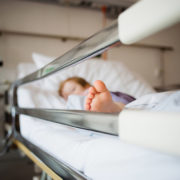California’s children’s hospitals say they’re struggling to keep up with advances in medical care and a growing demand for their services, and they’re asking taxpayers to help — again.
The California Children’s Hospital Association wants voters to pass a $1.5 billion bond measure to upgrade infrastructure and equipment at the state’s 13 children’s hospitals. It would be the third state bond for children’s hospitals in the past 14 years. In 2004, voters approved one for $750 million, and in 2008, they re-upped for $980 million.
Earlier this month, the association submitted 643,000 signatures to county election offices in an attempt to place the measure on the November ballot.
“As new breakthroughs in medicine enable children with complex health conditions to grow and thrive, the demand for specialized pediatric care is increasing,” said Ann-Louise Kuhns, president and CEO of the association.
The secretary of state will determine by the end of June whether the measure qualifies for the ballot.
Over a 35-year period, the proposal would cost the state a total of $2.9 billion in principal and interest, according to a summary by the state Legislative Analyst’s Office. That’s about $83 million a year.
David Wolfe, a legislative director with the Howard Jarvis Taxpayers Association, urged voters to be wary of bonds and suggested that hospital renovations could be funded by private donors or the state general fund, which wouldn’t come with the added interest costs.
“Bonds are not free money,” Wolfe said. “That’s money that is not spent paying off unfunded pension liabilities or funding K-12 education.”
But supporters of the initiative say it’s a price worth paying to update and expand the hospitals, which treat the state’s sickest children. The money could be used only for construction and equipment.
The children’s hospitals include eight private nonprofits and five that are part of the University of California medical system. Other hospitals that treat children with special medical needs who are enrolled in the state’s California Children Services program would also benefit, though to a lesser degree.
About three-quarters of the bond proceeds would go to the eight private nonprofit hospitals, because they have the most pediatric beds, Kuhns explained. Each of these hospitals would be allowed to apply for $135 million.
Valley Children’s Healthcare in Madera is one of them. In 2017, the hospital, which serves all of Central California, logged 430,000 inpatient and outpatient visits, said Tim Curley, director of community and government relations.
Half of the hospital’s 330 beds are usually occupied by children with critical needs such as congenital heart disease, cancer, rare infections, cystic fibrosis, complex diabetes and Valley Fever, he said.
Curley estimated that 78 percent of all visits are paid for by Medi-Cal, the state’s Medicaid program for low-income residents.
Because all children’s hospitals rely heavily on Medi-Cal, which pays less than private insurance, they have had trouble saving money for construction, Kuhns said.
“This is why the bond act through the years has been really important to us,” Curley said. “It has allowed us to do things that we would have otherwise not been able to do.”
The two previous bond measures helped pay for a 60,000-square-foot expansion of operating rooms and other upgrades at Valley Children’s, he said. The hospital has made no decisions about how it would use the money should the current proposal be adopted, but it is considering possible renovations to its laboratories and pharmacy, he added.
Loma Linda University Children’s Hospital in the Inland Empire hopes to invest in both equipment and facilities to keep up with the area’s growing need, said Scott Perryman, a senior administrator there. The 350-bed hospital primarily serves children in Riverside and San Bernardino counties.
Loma Linda is currently using money from the 2008 bond to expand and to meet seismic requirements.
All of the children’s hospitals need to catch up with the latest medical innovations, Kuhns added.
“Think about what your cellphone was capable of 10 years ago and what it’s capable of today,” she said.
This story was produced by Kaiser Health News, an editorially independent program of the Kaiser Family Foundation. (Ana B. Ibarra/Kaiser Health News)







